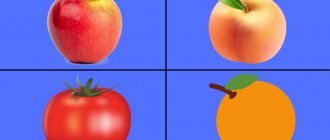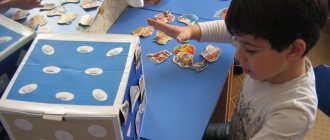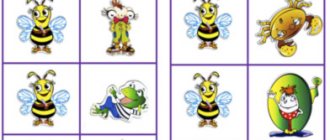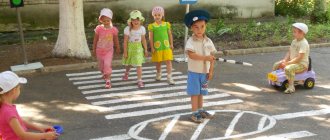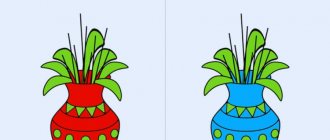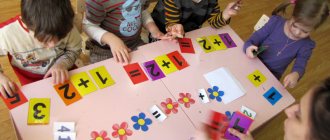Progress of the game: children are guided by the plan and layout.
"Continue the proverb"
Goal: to introduce oral folk word-making, to develop speech, memory, and logical thinking.
Progress of the game: The teacher begins the proverb , the children continue it.
“Birds of our city (region)
»
Goal: to introduce children to the birds of their hometown (region)
.Instill love for
the homeland , native land, the animal world, the desire to help and care. Material: cards with images of birds, album “Birds of our city, region”
, compiled together with
parents .
Progress of the game: The teacher shows the children cards with images of birds, asks them to name and determine whether the bird lives in our city or not.
"Riches of the bowels of the earth"
.
Goal: to expand children’s understanding of the richness of the earth’s interior in minerals (coal, minerals, iron ore, precious stones)
. Expand children's understanding of the internal structure of the earth.
Material: collection of earth's fossils, pictures and illustrations of the earth's natural resources.
Progress of the game - The teacher shows the children a picture (natural fossil)
offers to name it.
"The World of Objects"
Goal: to generalize children’s understanding that in the world around us many objects are made by man from materials of natural or artificial origin (using various materials, a person studies and uses their properties)
.
Foster cognitive activity.
Strengthen the ability to form adjectives. Material: Pictures and images of household items.
Didactic game “Walk around the city”
Card index of didactic games for children of senior preschool age on patriotic education.
Didactic game “What an artilleryman needs”
Objectives: To consolidate children’s knowledge about the military profession of artillery; develop visual attention; instill pride in our Army. Progress of the game Children choose photographs or pictures depicting military equipment, paraphernalia (tank, military aircraft, flag, pistol, horse, flask, binoculars, cannon, etc.). The selected pictures must correspond to the military profession of artilleryman. The child gives reasons for his choice (why the artilleryman needs this item).
Didactic game “Who will I serve in the Army?”
Objectives: To consolidate children's knowledge about military professions; develop imagination; instill pride in our Fatherland. Progress of the game Children are presented with pictures or photographs depicting weapons, equipment, objects and attributes used by the military. Based on the choice the child made, the military profession should be determined. Name what troops the child wants to serve in when he grows up.
Didactic game “Who protects our borders”
Objectives: To consolidate children's knowledge about military air, land, and sea transport; develop cognitive activity; educate patriots of your country. Progress of the game On the map of Russia, the teacher shows the borders of our country. Draws children's attention to the fact that borders pass not only on land, but also on water. He clarifies that it is also impossible to cross the border by air. Children answer the teacher’s questions regarding what type of military transport they use to protect the borders. Justify your answer. For example, if the enemy attacks from the sea, the border will be protected by warships and boats. If the threat is on land, then tanks, guns, and military equipment are on guard.
Didactic game “Make a map”
Objectives: To consolidate children's knowledge about the map of Russia; develop visual memory; instill pride in our Motherland. Progress of the game To carry out the game, preliminary work is required to familiarize preschoolers with maps of Russia, region, city, etc. A color physical map of Russia in A4 format is cut into 6-8 parts (depending on the age of the children). It is proposed to compile a whole map of the country from parts. Complication: collect a card against time.
Didactic game “Guess the military profession”
Objectives: to consolidate children’s knowledge about military professions (tanker, military pilot, artilleryman, border guard, etc.); develop observation and memory; cultivate love for the Motherland. Progress of the game The presenter (child) describes a representative of one of the military professions. Children must determine by their characteristic features who the presenter has wished for. Whoever guessed first becomes the leader.
Didactic game “Let’s collect a picture”
Objectives: To consolidate children's knowledge about military transport; develop fine motor skills of the hands; instill pride in our Army. Progress of the game Children are offered cut-out pictures of a tank, military aircraft, military helicopter, military boat, submarine, military vehicle. Offer to assemble a whole image from parts. Game options: children assemble a whole image from parts in pairs, make a whole from parts against time, at speed.
Didactic game “How our great-grandfathers defended the world”
Objectives: Reinforce the concepts: water, land, air military transport; develop visual and auditory attention; to cultivate a sense of pride in our great-grandfathers, who defended the world for us. Progress of the game: The child chooses a picture depicting a military profession. Selects military transport in accordance with the chosen profession. Then, in accordance with the chosen military transport, it “stops” at the border of our country. For example, profession - military sailor, transport - military boat, border - sea area.
“Who knows, he will guess!”
Target:
· Consolidate children’s knowledge about the sights of their hometown;
· Develop memory, speech;
· Cultivate observation and curiosity.
Progress of the game: The child, with his eyes closed, takes one postcard on the table with views of his hometown, then gives a brief description, without naming the place itself. The rest of the children ask leading questions until the place of their hometown is guessed. The child who answers correctly becomes the leader. The game repeats itself. At the beginning of the game, the teacher can give his story - a sample.
"Find the flag"
Target:
· To consolidate children’s ideas about the national flag;
· Develop attention and memory;
· Foster a sense of patriotism.
The presenter lays out postcards on the table with images of flags of different countries (about ten) and gives the children the task of finding the Russian flag. Then the teacher invites the children to close their eyes and at this time swaps the pictures.
“Find out the coat of arms of our country”
Target:
· To consolidate children's knowledge about the state emblem;
· Teach to recognize the coat of arms of other countries;
· Develop attention and memory;
· Cultivate a desire to learn something new.
Progress of the game: The teacher invites the children to look at the national flag of Russia and name what colors it consists of. Next, children are offered cut-out pictures (like puzzles). Children collect the Russian flag.
"There are guests in our city"
Target:
· Consolidate knowledge about your hometown in a playful way;
· Develop speech and memory;
· Cultivate love for your hometown.
Progress of the game: The teacher warns the children that now out-of-town guests who know nothing about our city will come to us. Children must give short descriptive stories about their hometown. The “guest”, with the help of leading questions, encourages children to talk about the climate, the flora and fauna, the symbolic meaning of the coat of arms, and names the name of the head of the city.
Didactic game “Walk around the city”
Objectives: to consolidate students’ ideas about the streets of the nearest microdistrict and the buildings located on them; expand understanding of buildings and their purpose; establish rules for safe behavior on the street; expand spatial representations (left, right, in front, behind, between, next to, opposite, in the middle, etc.); develop coherent monologue speech; cultivate love and respect for your hometown.
Material: green playing field, on which road maps with traffic lights and a green zone are indicated in gray; photographs of city institutions and institutions (10-15 pieces) closest to the kindergarten; permanent objects (landmarks) on the playing field (for example: airport, monuments, circus); cards with riddle poems – 10-15 pcs.; cubes with photographs of institutions pasted on each side - 3 pcs.; figurine of a man – 1 pc.; photographs of the city, cut into mosaic shapes.
The game can be played by one child or a subgroup of children – 3-5 people.
Preliminary work: targeted walks to nearby streets, examining the buildings located on them; conversations about what you can see when you open the door of the establishment, what it is intended for; viewing a photo album of the city; comparison of large photographs with small game cards; familiarization with the playing field - a diagram of the nearest streets.
Game options:
Option 1 – “Find a street.”
The child is asked to place a figurine of a man on the street that the teacher names. (All buildings are on the playing field).
Option 2 – “Riddles on the streets of the city.”
The game uses a playing field and poetry cards. The teacher hands out photographs to the playing children, reads riddle poems, and the children guess what kind of establishment they are talking about. The child who has a photo of the mysterious building places it on the playing field. You should strive to use spatial terms in speech. First, you can guess the most familiar objects closest to the kindergarten, then more distant ones.
Option 3 – “Get home.”
The child is asked to determine the location of his house on the playing field - place a figurine of a man there. The task is to describe the route from home to kindergarten and back, observing traffic rules.
Option 4 – “Show me the way.”
The game uses a playing field with all the objects attached to it and cubes with photographs. The child throws the dice. The task is to explain the way from the kindergarten to the establishment shown on the cube, observing the traffic rules.
Option 5 – “What’s mixed up?”
The teacher deliberately places photographs of buildings on the playing field incorrectly. Children are encouraged to correct mistakes by commenting on their actions.
Option 6 – “Complete the picture.”
Children are given the task, together with their parents, to walk along the streets closest to the kindergarten and find establishments there that are not found in the game.
Option 7 – “Assemble the mosaic.”
The cut fragments of photographs are mixed, the children have to correctly assemble the image and explain where it is and what it is intended for.
Progress of the game: Cook - cooks, fries, etc.
"Who are we? What are we like?
Goal: To consolidate children’s knowledge about man, to familiarize them with the external structure of the body and its capabilities, to develop the ability to compare and establish simple cause-and-effect relationships, to arouse interest in self-knowledge, to cultivate a caring attitude towards themselves and the world around them. Material: paintings and images of people (men and women.
Progress of the game: the teacher shows pictures with images and invites the children to find similarities and differences.
"Magic Words"
Goal: to evoke a desire to follow what is worthy of imitation, to objectively evaluate behavior, to cultivate a friendly and tolerant attitude towards people, the ability to compare and establish simple cause-and-effect relationships.
Material: paintings and images of people .
Progress of the game: cast iron - cast iron, wood - wood...
“On land, in the sky, on water, under water (transport)
»
Goal: Improving the grammatical structure of speech, consolidating prepositions in speech.
Material; a table showing the sky, sea, pictures : train, plane, steamship, truck, car, bus.
Progress of the game: The teacher asks the children to name small pictures , and then find a place for each of them in the big picture and make a sentence.
“On land, in the sky, on water, under water (animal world)
»
Goal: Improving the grammatical structure of speech, consolidating prepositions in speech.
Material; a table showing the sky, sea, pictures : animal world.
Progress of the game: The teacher asks the children to name small pictures , and then find a place for each of them in the big picture and make a sentence.
“Who needs what for work?”
Goal: To develop the ability to use the accusative and dative cases of nouns. Develop speech, logical thinking and memory. Strengthen knowledge about people's professions.
Card material depicting people of different professions.
Progress of the game: Children talk about professions, identify the items necessary for their work. (To the cook - ladle)
.
“Guessing and interpreting riddles”
.
(about the army, soldiers, Motherland , flora and fauna)
Goal: to introduce oral folk art, to promote children’s self-expression, the ability to make and guess riddles on a moral and patriotic theme .
Material: riddles and pictures with answers .
Progress of the game: the teacher makes a riddle , the children guess the riddle.
"Tell me which one"
Goal: to develop logical thinking, memory, speech, to develop skills in selecting definitions for words.
Material: cards with the image of the Motherland , flag, coat of arms, etc.
Progress of the game: The teacher shows the card and asks them to name what is depicted on it and select definitions for the image. ( Motherland is huge , powerful, beautiful, endless)
etc.
"Make a Family"
Goal: to develop logical thinking, memory, speech, to develop skills in selecting words of the same root and related words.
Material: cards with the image of the Motherland , flag, coat of arms, etc.
Progress of the game: The teacher shows a card and asks to name what is drawn on it and select related words with the same root: homeland , dear, parents , relative, mole ; hero - heroic, heroic, heroism; protection - protector, protect.
"Guess the profession"
Goal: To consolidate children's knowledge about professions. To develop the ability to divide professions into male and female.
Material: cards with images of people of different professions.
Progress of the game: An adult lists the actions of a person in a certain profession, and the children guess what kind of profession it is.
"I have a right."
Target. Expand the scope of children's legal knowledge.
Material: A set of narrative pictures for the articles of the “UN Convention on the Rights of the Child”
.
Pictures depicting situations not covered in the “Convention”
(a child riding a bicycle, playing hide and seek, watering flowers, etc.).
Progress of the game: Children take turns choosing a picture and explaining the reason for their choice, the rest discuss the correctness of the decision made.
"Who's doing what?"
Goal: to develop the skill of selecting verbs to nouns. Develop speech, logical thinking, memory.
Material: cards with images of people of different professions.
